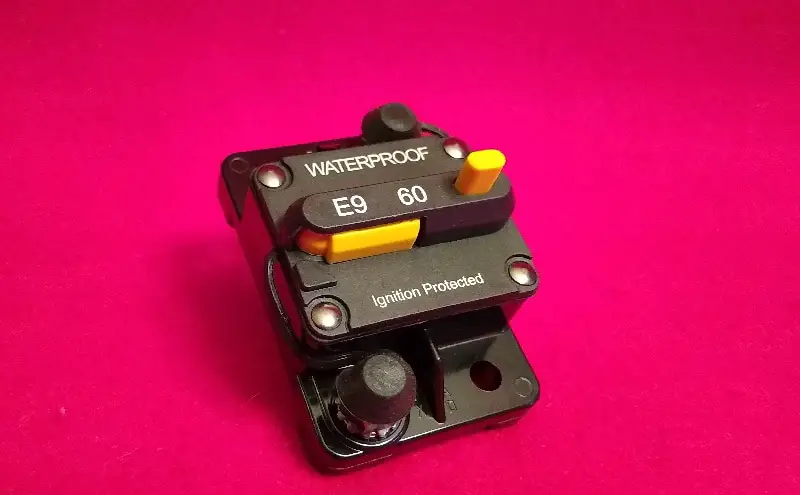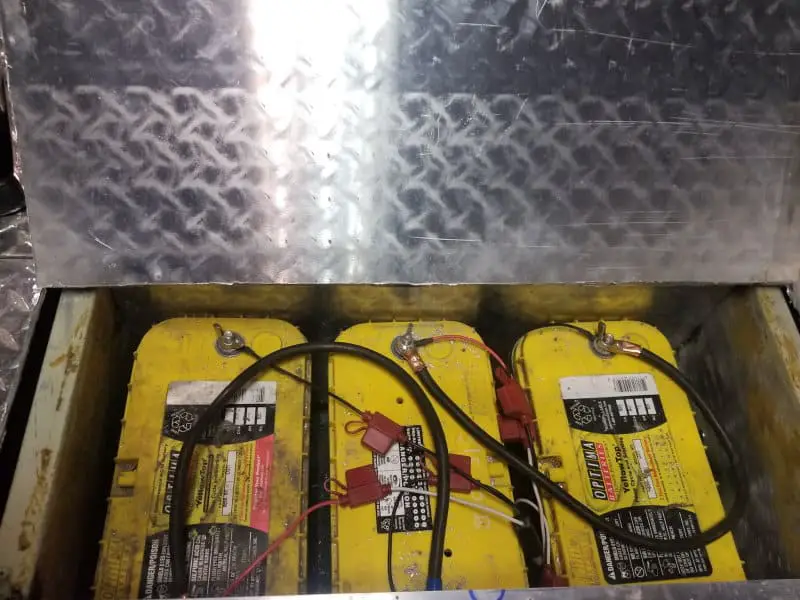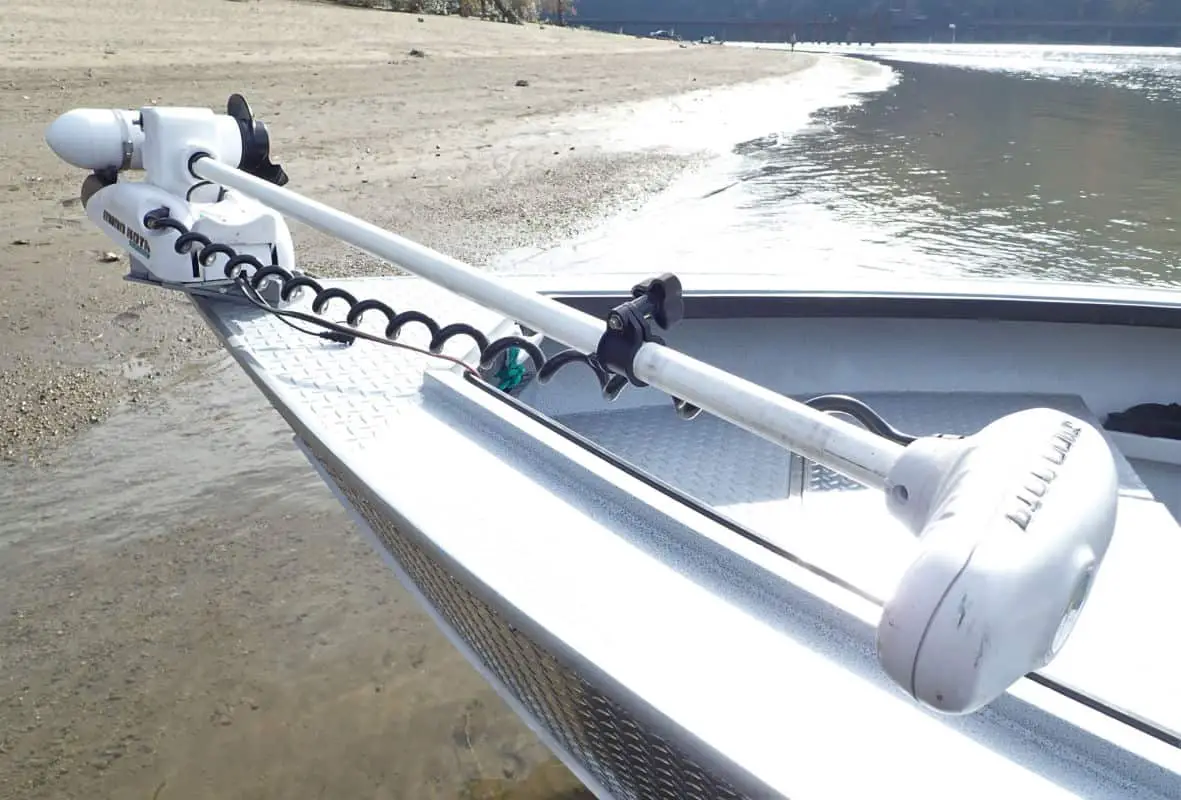Does a 24-volt trolling motor need two batteries?
In most cases, a 24-volt trolling motor does require two separate 12-volt deep cycle batteries in most cases. It is recommended that you purchase two identical deep cycle marine batteries. If used correctly match deep cycle batteries can have a lifespan of 6 years. Also, these batteries are more reliable and will provide maximum power when needed. In doing so, you ensure that you’ll be able to get yourself back to shore safe and sound every time.
Additionally, there are a few lithium batteries that are 24 volts, but the downside is there are very few 24 volt marine battery chargers.
Click here for our article How do I choose the proper size batteries for my electric trolling motor?

Do I need a 24-volt circuit breaker for my trolling motor?
No, the voltage of your circuit breaker is not the most significant factor in play here. What you want to be looking at is the amperage rating of the circuit breaker. Circuit breakers come in standard amp ratings like 20, 40, 60, and more. You should be looking for one that has an amp rating that is just above the amp draw of your trolling motor at maximum speed.
A motor circuit breaker is there to “trip” or break the circuit when it reaches a specified amperage. The most significant reason for a circuit breaker is to prevent fire in case your circuit goes to ground. Additionally, a circuit breaker prevents the motor from overloading and burning itself out. The amp rating of a circuit breaker is the amperage level it will break at. This’s why you want to get a breaker that trips above the amp level that your motor draws.
A 24-volt trolling motor at maximum speed draws around 45 or 50 amps, but definitely nothing more than 60 amps. The Maxxum 74 motor, for example, resides at 45 amps maximum draw. However, this number varies widely depending on wind, current, speed setting, boat weight, et cetera. You have to consider all these factors.
Based on approximate numbers, you might be looking for a circuit breaker that is rated at about 60 amps. The reason being is that if 60 amps are drawn from the trolling motor, you can be sure that it is undoubtedly operating at a level beyond its designed capacity, so it should be tripped. Remember, you do not need to purchase a brand-specific circuit breaker.
Any breaker that meets the specifications discussed above will work just fine for your motor. For most 24 volt trolling motors, a 60 amp breaker and wire rated to carry 60 amps for the length of your circuit should work great. Always check your user manual, and for more information, review our article on circuit breakers.
Click here to read our article on Circuit Breakers.
How do I know if my trolling motor is 12 or 24-volt?
First, look at the cover of your trolling motor. It should be clearly labeled whether you’ve got a 12 or 24-volt one. If that doesn’t pan out, the next step would be to look at the batteries. A 12-volt motor needs only one deep cycle battery in contrast to the two required by 24-volt trolling motors.
If you can confirm that there is only one battery, there is a 95% chance that it’s a 12-volt system. If, on the other hand, you observe two batteries, then you have to take a closer look at the wiring or setup.
A 12-volt trolling motor runs in a parallel circuit setup, where the two positive terminals connect to the positive trolling motor lead, while the two negative terminals are attached to the negative trolling motor lead. A 24-volt system, in contrast, has a series circuit setup.
So, you would be looking at a connection running from the positive (+) of one battery to the negative (-) terminal of the other battery. The wiring will tell you everything you need to know.

What’s the difference between 12, 24, and 36-volt trolling motors?
Trolling motors come in either a 12, 24, or 36-volt system. As mentioned a couple of times previously, a distinguishing difference between the three is the batteries they run on. A 12-volt trolling motor runs off one 12-volt deep cycle battery, while a 24-volt runs off of two, and a 36-volt, three. The 12-volt trolling motors are the most inexpensive, lightest, and require the least effort to run.
With that said, they fall far behind when it comes to thrust and the lasting time of the power. The only circumstance in which a 12-volt model might be suitable is if your boat is under 16 feet long. Even then, it would be wise to find a high-thrust model so that you’re adequately equipped for most conditions.
With any boat longer than 16 feet, your only safe bet would be to go for a 24 or 36-volt system. A 24 and 36-volt system will sustain you for much, much longer, as they draw lower amps while generating increased thrust and power. If you intend to spend all day out in the waters, a 12-volt model will not last, but 24 and 36-volt systems will.
What, then, is the difference between a 24-volt and 36-volt model? And is it worth the extra money and weight to upgrade to a 36-volt system? Here’s the rundown: if you’re planning on maneuvering windy conditions, fast river fishing, or if you have a heavy boat, you should go with a 36-volt, it will be worth it. If you plan on handling regular fishing, calm waters, and non-windy conditions, or if you have a light boat, you should go with a 24-volt trolling motor.
Click here to read our article 9 Reasons We Prefer 24 Volt Trolling Motors.
Can I mix old and new batteries for my trolling motor?
No, the short answer is always to try to replace them in pairs. Here’s why: Even if mixing the batteries likely won’t instantly break down the operation of your trolling motor, it will still cause long-term damage and reduce the lifespan of the batteries. When it comes to all batteries, a general rule of thumb is never to mix old and new batteries as it reduces overall performance and increases the risk of battery leakage or rupture.
Over time, as a battery gets older, its recharge and discharge rates change substantially. So, when you mix an old and a new battery and go to charge the two, you will end up overcharging the new battery because it charges faster, draining the life of that battery. Or, you might find that the old battery dies more frequently because it holds less energy, resulting in a much faster discharge rate, leaving you with the impossible task of maintaining these mismatched batteries.
Finally, the older battery will draw power from the newer battery, causing damage to the new battery.
What you can do is try your best to extend the life of the batteries as much as possible, which means recharging them slowly and keeping them well maintained. However, when the time comes to replace them, the only advisable choice is to throw both of the old ones out and start fresh.
We believe the future for trolling motors is going to be lithium batteries. While Lithium cost more upfront if you compare amp hours, charge cycles, and the 10 year warranty, lithium is half the cost.
Click here to read our article Lithium Trolling Motor Batteries Reviewed
Final Thoughts
We hope this article helped answer some common questions for your 24 volt trolling motor system.
For more information, read our Complete Guide to 24 Volt Trolling Motor Systems.



